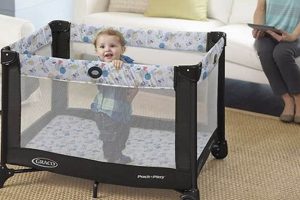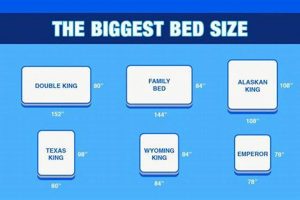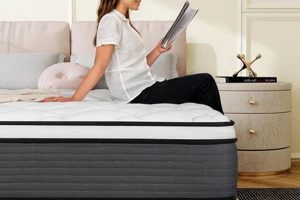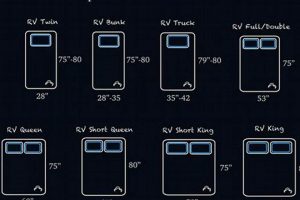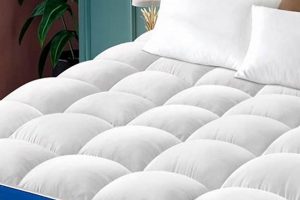A short queen mattress presents a sleep surface that measures approximately 60 inches wide and 75 inches long. This configuration differentiates it from the standard queen, which typically extends to 80 inches in length. The reduced length offers a solution for space constraints, particularly in RVs or smaller bedrooms where a standard queen might prove too cumbersome.
The adoption of this mattress dimension provides several advantages. It maximizes usable floor space within a confined area while still accommodating two adults comfortably. Its utility is not solely confined to recreational vehicles; apartments and guest rooms also benefit from the space-saving design. Historically, customized mattress sizes addressed specific needs; the short queen is a modern manifestation of that principle, tailored to compact living spaces.
Understanding this particular mattress dimension opens the door to exploring a range of related topics, including considerations for bedding, bed frames, and potential cost implications compared to standard sizes. Subsequent discussions will delve into these areas to provide a complete picture of this unique sleep solution.
Considerations for a Short Queen Mattress
This section outlines critical factors to evaluate when considering a short queen mattress purchase. Understanding these elements ensures a well-informed decision regarding space, comfort, and suitability.
Tip 1: Measure the Available Space Precisely: Accurately assess the dimensions of the intended room or vehicle. The short queen’s dimensions, 60 inches by 75 inches, must comfortably fit the allocated space without obstructing movement or other furniture. Avoid relying on estimates; exact measurements are crucial.
Tip 2: Evaluate Sleep Partner Compatibility: Determine if the reduced length of the short queen adequately accommodates the height of both sleepers. Individuals taller than 5’10” may find the reduced length restrictive, impacting sleep quality. Discuss needs and preferences with your partner before making a decision.
Tip 3: Source Appropriately Sized Bedding: Standard queen bedding will not fit a short queen mattress. Secure sheets, blankets, and comforters specifically designed for short queen dimensions to ensure a proper fit and avoid excess fabric or inadequate coverage. Specialized online retailers or custom bedding services may be necessary.
Tip 4: Investigate Bed Frame Availability: Bed frames designed for short queen mattresses may be less common than standard sizes. Explore options with RV suppliers, custom furniture builders, or online retailers specializing in space-saving solutions. Ensure the chosen frame provides adequate support and stability for the mattress and occupants.
Tip 5: Assess Mattress Firmness and Material: As with any mattress purchase, consider individual preferences for firmness level and material composition. Short queen mattresses are available in various materials, including memory foam, innerspring, and hybrid options. Test different options when possible to determine the most comfortable choice.
Tip 6: Understand Return Policies and Warranties: Before finalizing the purchase, carefully review the retailer’s return policy and the manufacturer’s warranty. Due to the specialized nature of short queen mattresses, return options may be limited. Understand the terms and conditions to protect your investment.
Adhering to these considerations streamlines the selection process, mitigating potential issues related to space, comfort, and compatibility. A thorough evaluation ensures the short queen mattress meets specific needs and maximizes user satisfaction.
The subsequent section will address potential alternatives to short queen mattresses, exploring other space-saving sleep solutions.
1. Width
The measurement of sixty inches for width constitutes a fundamental element in defining “what size is a short queen mattress.” This dimension is not merely an arbitrary number; it has significant implications for comfort, usability, and practical applications.
- Sleep Surface Area
The sixty-inch width directly dictates the available sleep surface for two occupants. It ensures sufficient space for two adults to sleep reasonably comfortably without excessive crowding. This width is a standardized feature across all queen-sized mattresses, irrespective of their length variations.
- Bed Frame Compatibility
Bed frames designated as “queen” are designed to accommodate a mattress width of sixty inches. Whether the mattress is a standard queen, short queen, or any other queen-sized variant, the width remains constant, ensuring compatibility with a wide array of bed frames. Any deviation from this width would require a custom-built frame, increasing cost and complexity.
- Bedding Standardization
While short queen mattresses necessitate specific lengths of bedding, the consistent sixty-inch width allows for shared usage of queen-sized flat sheets. Fitted sheets, however, must correspond to the short queen’s unique dimensions. This blend of standardized and specialized bedding requirements represents both convenience and a unique constraint associated with this mattress type.
- Spatial Efficiency
The sixty-inch width is a critical factor in the overall space efficiency offered by a short queen mattress. While the reduced length is the primary space-saving feature, the width must also be considered in the context of the room’s dimensions. In compact environments, even a standard queen’s width might prove problematic, further emphasizing the need for meticulous measurement and planning.
These facets underscore the pivotal role of the sixty-inch width in understanding “what size is a short queen mattress.” While the length differentiates it from a standard queen, the standardized width maintains compatibility with existing infrastructure and contributes to the mattress’s overall functionality and user experience.
2. Length
The measurement of seventy-five inches for the length of a short queen mattress constitutes the defining characteristic that sets it apart from the standard queen size. This reduced length directly influences its suitability for various applications and environments, warranting detailed examination.
- Space Optimization in Confined Areas
The seventy-five-inch length allows a short queen mattress to fit comfortably within spaces where a standard eighty-inch queen would be impractical. Recreational vehicles (RVs), smaller bedrooms, and guest rooms benefit from this reduction in length, maximizing usable floor space and facilitating easier maneuverability. This adaptation prioritizes spatial efficiency without compromising width.
- Accommodation of Height Considerations
The reduced length presents a critical consideration for taller individuals. Those exceeding approximately five feet ten inches may experience discomfort due to insufficient legroom. This highlights the importance of assessing individual height and sleep preferences before opting for a short queen mattress. Shorter individuals or those who prefer a curled sleeping position may find this length adequate.
- Impact on Bedding Selection
Standard queen-sized sheets, blankets, and comforters are designed for mattresses eighty inches in length. Utilizing standard bedding on a short queen mattress will result in excess material that can be cumbersome and aesthetically unappealing. Specialized short queen bedding is required to ensure a proper fit and maintain a neat and functional sleep environment. This specialized need can impact cost and availability.
- Influence on Frame Compatibility
While the sixty-inch width allows compatibility with standard queen-sized bed frames, the seventy-five-inch length necessitates a short queen-specific frame. Standard queen frames will not adequately support the shorter mattress, potentially leading to structural issues and reduced comfort. Identifying and acquiring an appropriate frame is a crucial step in the setup of a short queen mattress.
In summary, the seventy-five-inch length is the key differentiating factor in “what size is a short queen mattress.” Its impact extends beyond mere dimensions, influencing spatial efficiency, user comfort, bedding requirements, and frame compatibility. Thorough consideration of these factors is essential for making an informed decision about the suitability of this specialized mattress size.
3. Area
The calculated area of 4500 square inches represents the total sleep surface available on a short queen mattress. This figure, derived from multiplying the width (60 inches) by the length (75 inches), serves as a key indicator of the mattress’s capacity to accommodate one or two sleepers. Its significance lies in its direct correlation to comfort and spatial efficiency within a bedroom or RV.
- Comparative Surface Area
Understanding the 4500 square inch area is best achieved through comparison. A standard queen mattress, with dimensions of 60 inches by 80 inches, offers 4800 square inches of surface area. This 300 square inch difference, while seemingly small, can impact the perceived spaciousness of the sleep surface, particularly for couples. Conversely, a full-size mattress typically provides approximately 4050 square inches, highlighting the short queen’s advantage in accommodating two individuals, albeit in a more compact format.
- Spatial Efficiency Metric
The 4500 square inch area directly translates to spatial efficiency within a room. In RVs, campers, or smaller bedrooms, every inch of available space is crucial. The reduced length of the short queen, resulting in a smaller overall area compared to a standard queen, allows for improved maneuverability and the inclusion of other essential furniture items. The 4500 square inch area represents a conscious trade-off between sleep surface and room functionality.
- Impact on Sleep Comfort
The total sleep area contributes to the overall comfort experienced during sleep. A larger area allows for greater freedom of movement and reduces the likelihood of disturbing a sleep partner. While the short queen’s 4500 square inches offers a reasonable level of comfort, individuals who are accustomed to a larger sleep surface may find it restrictive. The suitability of this area is contingent upon individual preferences and sleeping habits.
- Basis for Bedding Calculations
The 4500 square inch area, while not directly used in determining bedding sizes, serves as a foundation for manufacturers designing short queen sheets, blankets, and comforters. The overall dimensions derived from this area inform the cut and drape of these textiles, ensuring a proper fit and avoiding excess fabric or inadequate coverage. Accurate understanding of the surface area is critical for achieving both functionality and aesthetics in bedding selection.
In conclusion, the area of 4500 square inches is not merely a numerical value but a vital descriptor of the short queen mattress’s capacity and functionality. Its relationship to spatial efficiency, comparative surface area, sleep comfort, and bedding calculations underscores its importance in understanding the unique characteristics of this mattress size.
4. Shorter than standard
The descriptor “shorter than standard” is fundamental to defining what differentiates a short queen mattress from its conventional counterpart. This dimensional variance is not merely a negligible alteration but rather a defining characteristic with significant implications for application and suitability.
- Dimensional Distinction
The primary role of “shorter than standard” lies in establishing a clear dimensional distinction. A standard queen mattress measures 80 inches in length, whereas a short queen is typically 75 inches long. This five-inch reduction is the critical element that defines the size and purpose of a short queen mattress. This dimensional difference is a key selection factor in space-constrained environments such as recreational vehicles and smaller apartments.
- Spatial Adaptation
“Shorter than standard” directly facilitates spatial adaptation. The reduced length allows the mattress to fit within areas where a standard queen would be physically prohibitive. For example, in an RV, the limited floor space often necessitates the use of a short queen to maximize living area and allow for other essential amenities. This adaptation is crucial for optimizing functionality in confined environments.
- Bedding Compatibility Challenges
The “shorter than standard” length introduces bedding compatibility challenges. Standard queen-sized sheets and blankets will not fit properly on a short queen mattress, leading to excess fabric and potential discomfort. Therefore, specialized short queen bedding must be sourced, adding an extra layer of complexity to the purchase and maintenance of this mattress type. This need for specialized linens underscores the importance of considering all factors before opting for a short queen.
- Frame Selection Considerations
The “shorter than standard” length also influences bed frame selection. While the width remains consistent with standard queen sizes, the reduced length requires a frame designed specifically for short queen mattresses. Standard queen frames will not provide adequate support, potentially compromising comfort and mattress longevity. Consequently, careful frame selection is paramount to ensure a stable and supportive sleep environment.
The “shorter than standard” attribute fundamentally shapes the functionality and application of a short queen mattress. It dictates its suitability for specific spaces, influences bedding selection, and necessitates careful frame consideration. Understanding the implications of this dimensional difference is crucial for making an informed decision and optimizing the benefits of this specialized mattress size.
5. RV, camper friendly
The attribute “RV, camper friendly” is intrinsically linked to “what size is a short queen mattress.” The limited interior dimensions of recreational vehicles and campers necessitate space-saving solutions. A standard queen mattress’s length often exceeds the available space within these mobile dwellings. The reduced length of the short queen directly addresses this spatial constraint, enabling a larger bed to be incorporated into a smaller footprint. This compatibility stems from the cause-and-effect relationship: limited space causes the need for shorter mattresses. The “RV, camper friendly” aspect is therefore a critical component in understanding the definition and purpose of this mattress size.
Consider a Class B RV, often characterized by its compact size. A standard queen bed would dominate the available living space, hindering movement and limiting storage options. A short queen, conversely, allows for a more functional layout, facilitating the inclusion of seating, storage, and other essential amenities. Numerous RV manufacturers specifically design sleeping areas to accommodate short queen mattresses, recognizing their space-saving benefits. This design choice allows for increased comfort without sacrificing the functionality of the living space. The practical application of this design is the maximization of living area in compact spaces.
In summary, the “RV, camper friendly” descriptor is not merely a marketing term, but a direct reflection of the short queen’s optimized dimensions. The mattress’s size directly addresses the spatial limitations inherent in recreational vehicles. Understanding this connection facilitates informed decisions for consumers seeking comfortable sleep solutions without compromising the functionality of their mobile living space. Challenges might arise in sourcing properly sized bedding, but the spatial advantages generally outweigh this inconvenience.
6. Specialty bedding required
The phrase “Specialty bedding required” represents a direct consequence of the unique dimensions defining “what size is a short queen mattress.” Standard queen-sized sheets, blankets, and comforters are designed to fit mattresses that are 80 inches in length. A short queen, measuring 75 inches long, renders standard bedding ill-fitting. This misfit introduces practical problems, including excess fabric bunching, inadequate coverage, and compromised aesthetic appeal. The need for specifically sized bedding is, therefore, not merely a suggestion but a functional necessity arising directly from the altered dimensions.
The ramifications of “Specialty bedding required” extend beyond mere convenience. The availability and cost of short queen bedding can present challenges. Mass-market retailers frequently prioritize standard sizes, resulting in limited selection and potentially higher prices for short queen linens. Consumers may need to explore online retailers, specialty bedding stores, or custom-made options to secure properly fitting sheets and blankets. Ignoring this requirement results in a poorly made bed, diminished comfort, and potentially increased wear and tear on both the bedding and the mattress itself. The practical significance of this understanding lies in budgeting appropriately and anticipating the need for specialized sourcing.
In summation, “Specialty bedding required” is an integral component in fully comprehending “what size is a short queen mattress.” It underscores the functional adjustments necessitated by the non-standard dimensions and emphasizes the importance of accounting for specialized needs when making a purchase. While the space-saving benefits of a short queen are undeniable, the bedding implications must be factored into the decision-making process to ensure both comfort and practicality. Overlooking this aspect can lead to frustration and unexpected expenses, thereby diminishing the overall value proposition of this mattress size.
7. Space optimization priority
The phrase “Space optimization priority” is inextricably linked to the rationale behind the existence of “what size is a short queen mattress.” The defining characteristic of this mattress size its reduced length compared to a standard queen directly reflects a deliberate design choice to maximize usable area. Situations where floor space is limited, such as recreational vehicles, smaller apartments, or guest rooms, necessitate creative solutions to accommodate essential furnishings. The short queen emerges as a viable option when a standard queen proves too cumbersome, obstructing movement or limiting the inclusion of other necessary amenities. Thus, the mattress’s dimensions are a direct consequence of prioritizing efficient use of space.
Consider the practical application of this principle within a compact travel trailer. The limited floor space mandates careful planning to accommodate sleeping arrangements, seating, storage, and a kitchenette. Employing a standard queen mattress would severely restrict movement and potentially eliminate the possibility of including a small dinette or adequate storage compartments. A short queen, however, allows for a more functional and livable layout. Similarly, in urban apartments where square footage commands a premium, utilizing a short queen in a guest room or smaller bedroom can free up valuable space for a desk, seating area, or additional storage. These examples underscore the pragmatic advantages of the short queen when “Space optimization priority” dictates design choices.
In conclusion, “Space optimization priority” is not merely a desirable attribute but the fundamental driving force behind the development and adoption of the short queen mattress size. Its dimensions reflect a conscious trade-off between sleep surface area and overall room functionality. Understanding this connection is critical for consumers seeking to maximize the usable space in their dwellings or mobile living environments. Although the need for specialized bedding introduces a minor inconvenience, the spatial benefits often outweigh this drawback, making the short queen a valuable solution when efficient use of space is paramount.
Frequently Asked Questions
This section addresses common inquiries regarding short queen mattresses, providing factual information to aid in informed decision-making.
Question 1: What are the exact dimensions of a short queen mattress?
A short queen mattress measures approximately 60 inches in width and 75 inches in length.
Question 2: How does a short queen mattress differ from a standard queen mattress?
The primary difference lies in the length. A standard queen is 80 inches long, while a short queen is 75 inches long. The width remains consistent at 60 inches.
Question 3: Can standard queen-sized bedding be used on a short queen mattress?
Standard queen-sized fitted sheets are not suitable for a short queen mattress due to the length discrepancy. Flat sheets can sometimes be adapted, but specialty short queen bedding is generally recommended.
Question 4: Are short queen mattresses primarily intended for RVs?
While often used in recreational vehicles due to space constraints, short queen mattresses are also suitable for smaller bedrooms, guest rooms, or apartments where space optimization is a priority.
Question 5: Will a standard queen-sized bed frame support a short queen mattress?
A standard queen-sized bed frame will not provide adequate support for a short queen mattress due to the length difference. A short queen-specific frame is required.
Question 6: Are short queen mattresses more expensive than standard queen mattresses?
The price can vary depending on the manufacturer and retailer. Due to their specialized nature, short queen mattresses may sometimes be slightly more expensive than standard queen mattresses, but this is not always the case.
Understanding these key aspects of short queen mattresses facilitates appropriate selection and usage.
The subsequent section will explore potential alternatives and relevant size comparison charts.
What Size is a Short Queen Mattress
This exposition has thoroughly addressed the question, “what size is a short queen mattress,” delineating its dimensions as approximately 60 inches in width and 75 inches in length. The analysis clarified the key distinctions between the short queen and its standard counterpart, emphasizing the space-saving benefits in environments such as recreational vehicles and smaller living spaces. The necessity for specialized bedding and appropriately sized bed frames was also highlighted as a crucial factor in informed purchasing decisions. The exploration extended to the inherent trade-offs between sleep surface area and spatial efficiency, underscoring the importance of individual needs and preferences.
Ultimately, the understanding of “what size is a short queen mattress” empowers consumers to make well-informed choices that align with their specific spatial constraints and comfort requirements. Continued awareness of specialized bedding options and bed frame availability will further optimize the utility and value of this unique mattress size. Proper consideration of these factors ensures that the benefits of this space-saving solution are fully realized.



